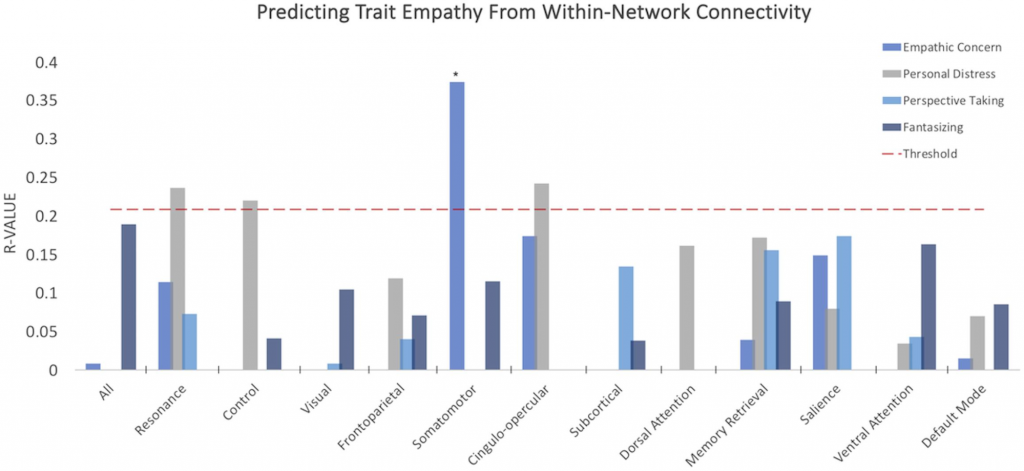By Tiffany Liang
How would you tell how empathetic someone is? You might base it off of how they react to emotional situations, how caring they are, how well they pick up on the feelings of others, and so on. Here’s a brain teaser: how would you tell how empathetic someone is, without asking them any questions or using any kind of emotional stimuli?
If you thought about examining someone’s brain, then perhaps you are on the right track. The processing of empathy at the neural level can be split into two contexts: self-other resonance, or the sharing or mirroring of another’s emotions or behavior, and top-down control, which understands thoughts or feelings through logical deduction. If these processes are governed by set neural networks, then theoretically you could determine someone’s empathy levels just by examining their neural circuitry. A recent study published in Frontiers examined this relationship and found results that supported the possibility of evaluating a person’s empathy just by having them undergo a MRI scan.
In the study, 58 participants between 18-35 years old filled out an Interpersonal Reactivity Index (IRI) questionnaire designed to measure empathy. The IRI measures empathy in four areas. One: fantasizing scale, or “the tendency to take the perspective of a fictional character.” Two: empathetic concern, or “the sympathetic reactions to the distress of others.” Three: perspective taking. Four: personal distress, or “the aversive reactions to the distress of others.” An interesting note is that female participants ranked much higher in Personal Distress than male participants, while the other three areas had no significant difference between female and male participants.
The researchers then had the participants undergo an MRI screening in which they stared at a neutral, non-stimulating image. The researchers hypothesized that a person’s empathetic function is determined by stable interactions between the self-other resonance and top-down control processes in the brain. Machine learning’s regression models calculated test statistics for each participant’s “feature set” of relevant ROI (region of interest) MRI data. The findings suggested that there are indeed set neural interactions indicative of a person’s ability to empathize. Researchers also found that these interactions take place even when the person is not actively engaging in “empathetic” behavior. They also found that empathetic concern was predicted by activity inside the somatomotor network (processes movement and sensation).
On a broader level, these findings imply that the resting and active brain may not be as distinct as previously believed, which could also have profound implications in psychiatry. It could help scientists understand the workings behind empathetic functioning as well as diagnose and potentially treat abnormal behavior. Being able to predict empathy this way could also be helpful in testing individuals who would have difficulty taking conventional empathy tests to determine the potential for social functioning after therapy.
Empathy serves an integral role not only in fostering helpfulness and compassion in people, but also in the functioning of a healthy society. Individuals with higher empathy report more meaningful relationships and greater life satisfaction, while those with low empathy are more likely to have less positive interpersonal relations. In the healthcare system, patients who received unempathetic care are more likely to disregard medical recommendations; at the governmental level, a lack of empathy leads to the marginalization of minority groups. Better understanding empathy and the mechanisms behind it can help us work towards a stronger community for all.
References:
Christov-Moore, L., Reggente, N., Douglas, P. K., Feusner, J. D., & Iacoboni, M. (2020, January 13). Predicting Empathy From Resting State Brain Connectivity: A Multivariate Approach. Retrieved from https://www.frontiersin.org/articles/10.3389/fnint.2020.00003/full
Grühn, D., Rebucal, K., Diehl, M., Lumley, M., & Labouvie-Vief, G. (2008). Empathy across the adult lifespan: Longitudinal and experience-sampling findings. Emotion (Washington, D.C.), 8(6), 753–765. https://doi.org/10.1037/a0014123
Riess H. (2017). The Science of Empathy. Journal of patient experience, 4(2), 74–77. https://doi.org/10.1177/2374373517699267
\https://www.ncbi.nlm.nih.gov/pmc/articles/PMC5513638/

